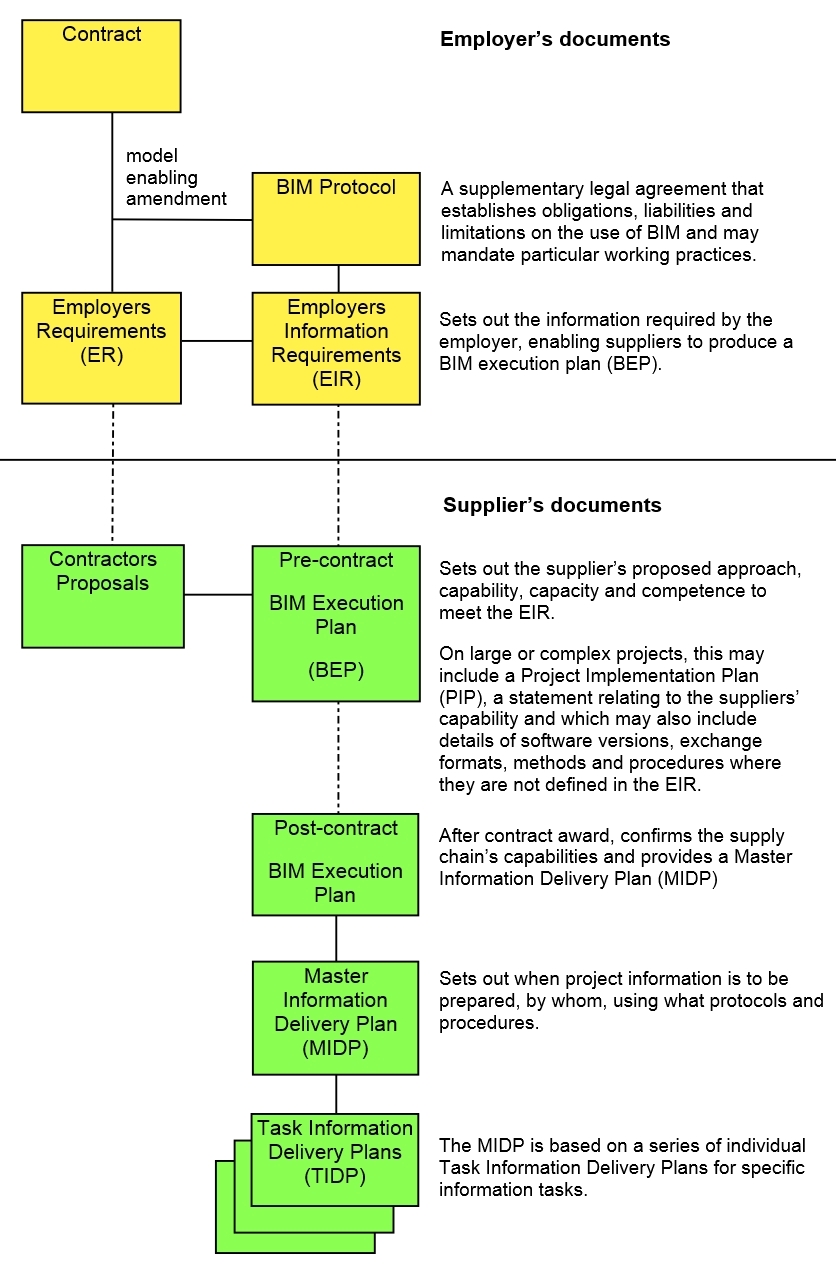Employer's information requirements EIR
Building Information Modelling (BIM) is a very broad term that describes the process of creating and managing digital information about a built asset such as a building, bridge, tunnel and so on. In the UK the government requires fully collaborative 3D BIM (with all project and asset information, documentation and data being electronic) as a minimum on centrally-procured public projects from 4 April 2016. This represents a minimum requirement for level 2 BIM.
Projects that incorporate level 2 BIM ensure appropriate information is created and shared in a suitable format at the right time so that better decisions can be made throughout the delivery and operation of a built asset.
The employer's information requirements (EIR) define the information that will be required by the employer from both their own internal team and from suppliers for the development of the project and for the operation of the completed built asset. Relevant extracts from the employer's information requirements are included in procurement documents for the appointment of each supplier appointed directly by the employer, which may include; advisors, consultants, contractors and so on.
Prospective suppliers respond to the employer's information requirements with a pre-contract BIM execution plan from which their proposed approach, capability and capacity can be evaluated.
Development of the employer's information requirements is likely to be an iterative process:
- Initially, it might take the form of a simple information requirements process map which identifies the key decisions that will need to be made during the project to ensure the solution developed satisfies the business need, and defines in very broad terms the information that will be needed to make those decisions.
- It develops to identify the required material, functional and performance information about facilities, floors and spaces.
- As the design progresses it identifies more specific requirements about the proposed systems and building components to support procurement.
- By the end of the project it defines the need for information to support the maintenance and operation of systems and components that are actually installed.
The employer's information requirements should clearly articulate the information requirements for each supplier and describe the expected information deliverables in terms of documents, model files and structured information. It should also define how and when information should be exchanged in the project lifecycle.
However, the exact nature of the employer's information requirements will depend on the complexity of the project and the experience and requirements of the employer. Experienced employers may develop very detailed employer's information requirements, whilst others may only set out high-level requirements, and some basic rules, leaving the supplier to propose how those requirements will be met.
Very broadly, depending on the employer, employer's information requirements may include:
- Standard methods and procedures defining the way information is created, named and exchanged.
- Information-related roles and responsibilities giving a clear definition of the information-related roles and what is expected from them.
- An information delivery plan or release schedule identifying which information deliverables should be delivered, by whom and when.
- A COBie demand matrix identifying which structured data about the facility, floors, spaces, zones and building components should be delivered and when.
PAS 1192-2:2013 Specification for information management for the capital/delivery phase of construction projects using building information modelling, specifies the requirements for level 2 BIM and suggests that the employer's information requirements should include:
Information management:
- Levels of detail (requirements for information submissions at defined project stages).
- Training requirements.
- Planning of work and data segregation (model management, naming conventions, etc.)
- Co-ordination and clash detection.
- Requirements for bidders' proposals for the management of the co-ordination process.
- Requirements for bidders' proposals for the management of the collaboration process.
- Requirements for bidders' proposals for BIM / common data environment supported health and safety / CDM management.
- A schedule of any security and integrity requirements for the project.
- A schedule of any specific information to be excluded or included in information models.
- A schedule of constraints set by the employer on the size of model files, the size of extranet uploads or emails, or the file formats that can define the size of a volume.
- Other project specific items such as pre-construction surveys or a requirement for the employer to receive information models describing newly-generated products and assemblies.
- A definition of any co-ordinate origin/system.
- A schedule of any software formats, including version numbers, to be used by the supply chain to deliver the project (or the formats of any outputs). NB PAS 1192-2 suggests that, 'Public sector employers may not wish to or be able or specify software packages to be used by their suppliers, but may instead specify the formats of any outputs. Private sector employers may choose to specify software packages and/or output formats.'
Commercial management:
- Alignment of information exchanges, work stages, purpose and required formats.
- Details of the expected purposes for information provided in models.
- An initial responsibility matrix setting out any discipline responsibilities for model or information production in line with the defined project stages.
- A schedule of the standards and guidance documents used to define the BIM processes and protocols to be used on the project.
- A schedule of any changes to the standard roles, responsibilities, authorities and competences set out in the contract.
Competence assessment:
- Details of the competence assessment which bidders must respond to.
- Changes to associated tender documentation.
- BIM tender assessment details.
The contractual status of the employer's information requirements can be established by referencing it in, or appended it to a BIM protocol. The BIM protocol (such as the freely-available CIC BIM protocol) sets out the contractual definition of BIM responsibilities, liabilities and limitations. The contract used for appointments can be appended with a BIM protocol by the addition a model enabling amendment clause.
The relationship between the employer's information requirements and other contract documentation is illustrated below:
The UK government-sponsored nbs BIM Toolkit has be developed to support the production of employer's information requirements.
[edit] Related articles on Designing Buildings
- Asset information model.
- Asset information requirements.
- Building Information Modelling.
- BIM dimensions.
- BIM execution plan.
- BIM process map.
- Client BIM adviser.
- CIOB Complex Projects Contract.
- Digital plan of work.
- Employer's decision point.
- Exchange information requirements.
- Government Construction Strategy.
- Information requirements.
- Invitation to tender.
- Level of detail.
- Organisational information requirements.
- PAS 1192-2:2013.
- Plain language questions.
IHBC NewsBlog
IHBC Publishes C182 focused on Heating and Ventilation
The latest issue of Context explores sustainable heating for listed buildings and more.
Notre-Dame Cathedral of Paris reopening: 7-8 December
The reopening is in time for Christmas 2025.
Stirling Prize-winning Salford building to be demolished
The Centenary Building will be bulldozed as part of the wider £2.5bn Crescent regeneration project
Volunteers work to transform 100-year-old ‘hidden’ building into bothy
The building, named Druimnashallag, is located southeast of Oban.
The new ‘Arches for HERs’ Demo site, from the Getty Conservation Institute via HE
It shows how organisations responsible for historic environment records (HER) management can benefit from its powerful features.
ICOMOS-CIF 2024 Symposium celebrates 40th anniversary in Venice
It aims to critically review current practices and theories of conservation of built heritage around the world, and more.
HES establishes new national centre for retrofit of traditional buildings
HES plans to develop the centre follows £1m of funding from UKRI Arts and Humanities Research Council.
High Court rejects oral appeal against tower block decision in historic Bloomsbury
The request was for a full Judicial Review hearing against Camden Council’s approval of a 74m-high tower block in Bloomsbury.
Mayor of London and Government announce bold plans to transform Oxford Street
Plans include turning the road into a traffic-free pedestrianised avenue, creating a beautiful public space.
Crystal Palace Subway, for 160th anniversary
The remarkable Grade II* listed Crystal Palace Subway in South London begins a new era following major restoration.
















